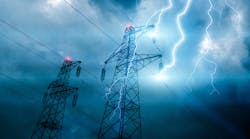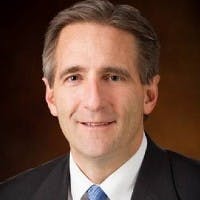They don’t always go together well, but short-term urgency and long-term vision must be parallel tracks in guiding the nation’s electric grid as it faces enormous challenges both immediate and in the future.
Shawn Schukar, chairman and president of Ameren Transmission and a three-decade veteran of the grid sector, acknowledges the dual tensions brought by tomorrow’s storms and the next decade’s diffusion of the electric system. He will bring those insights to the inaugural T&D World Conference and Exhibition, happening Oct. 5-7 at the Downtown Sheraton in Charlotte.
Schukar offered some of his experienced thoughts on questions asked by T&D World. They touch on everything from transmission system upgrades to new lines and the specter of handling more and more distributed energy resources on the system.
The T&D World Conference sessions featuring Schukar, “Critical Infrastructure at Critical Times,” will cap off the event’s first day on Wednesday afternoon, Oct. 5. The panel also includes leaders from Power Delivery Intelligence Initiative, National Grid, the California Independent System Operator and Xcel Energy.
Overall, the T&D World Conference and Exhibition includes dozens of experts from the nation’s grid entities. Utilities and other entities involved in the program include host Duke Energy, Electric Power Research Institute, Pedernales Electric Cooperative, Exelon, Entergy, Daimler Trucks, Edison Electric Institute, DTE Energy, Portland General Electric, Itron, Florida Power and Light, OGE Energy, LUMA, Salt River Project, Oncor Electric Deliver, Hitachi Energy, 1898 & Co., ComEd, Southwest Power Pool and Eversource Energy, among others.
T&D World: What are the top challenges/issues the electricity transmission industry faces?
Schukar: “Over the last decade, Ameren, and the broader utility industry, have been making significant investments to transition our transmission, distribution, and generation to meet customers’ ever-changing expectations related to improved reliability, resiliency, and access to low-carbon energy resources. As our customers become more dependent on electric energy to support their transportation, heating and cooling, entertainment, and other efficient electrification technologies, they’re also looking for lower impacts to the environment from energy sources. The electric system, including transmission, will become more complex and require higher and higher levels of reliability and greater levels of security and resiliency than we have ever seen.
“The pace of these changes is accelerating, and that timing is creating challenges as we make the necessary investments to address the transmission system changes. One of the key challenges is maintaining the reliability of the system with the coordination of outages necessary to support the investments that will enable the integration of low-carbon resources. Another challenge is ensuring these system investments minimize the total cost to the customer with the negative cost pressures from inflation, limited resource availability, supply chain issues and other macroeconomic forces. This includes the challenge of recruiting and training the workforce needed to make the investments today and operate the system of the future.
“And as we prepare for the future, we must keep a close eye on the development and pace of technology changes that could affect the needs and cost of the transmission system. Ultimately, we will look to implement those new technologies at a point that maximizes both customer reliability and affordability.”
T&D World: What are the greatest opportunities you see for the electric utility industry moving forward?
Schukar: “At Ameren, we put the customer at the center of everything we do and are focusing on providing solutions that help customers manage their costs and environmental impact while also delivering both reliable and resilient service. We are going about it in a way that meets the needs of a broad range of customers while also providing opportunities for diverse stakeholders. The clean energy transition comes with the opportunity to bring even more benefits to our customers and communities, impacting economic opportunities in a multitude of ways. As we make investments to improve system reliability and access to low-carbon resources, we continue to identify ways to better serve the customer’s differing needs while creating jobs and opportunities in our communities.
“Investments in the transmission grid across the Ameren system have enhanced reliability, resiliency and allowed access to a greater variety of low- and zero-carbon resources. We have seen success developing and building transmission projects that deliver these benefits on-time and on-budget to communities across the Midwest through the Multi-Value Project (MVP) process. We anticipate our customers realizing similar benefits coming out of the Midcontinent Independent System Operator's (MISO) recent Long-Range Transmission Planning (LRTP) process which will drive deeper access to renewable resources with a similar benefit-to-cost ratio as the MVP projects.
“The LRTP projects represent an incredible opportunity for our industry to show how we can deliver these important, necessary projects to enhance reliability, improve system performance and access diverse generation sources for customers across the country. These projects provide tremendous value and offer benefits many times greater than their initial cost while presenting us with an opportunity to implement new methods and technologies. However, these LRTP projects are only part of the overall regional planning that we are engaged in with others in MISO and those along its borders to capitalize and deliver on opportunities on behalf of our customers.”
T&D World: What promising technologies will help transmission companies meet their challenges and better manage their assets?
Schukar: “New technology brings the opportunity to improve designs on our system and drive out costs for our customers through several pathways, including automation, improved processes, and better materials.
“For our day-to-day operations, technology enhances our ability to monitor and manage systems. For the past several years, we have invested in system automation and self-healing equipment to reduce the frequency and duration of outages, which has a direct, positive impact on our customers.
“To give you some additional real-world applications, the use of advanced imagery is an exciting area, particularly using satellites and drones as an aid in vegetation management. These tools can detect growth patterns and tree health, helping us with ongoing maintenance. Utilizing drones and artificial intelligence modeling, we can identify equipment issues and asset conditions. These programs detect anomalies in a fraction of the time that it would take for a human to process the images. We also utilize drones for routine inspections and determining damage assessment following storms. The drones speed up our inspections, which helps reduce outage durations for our customers, and lower hazards for our crews.
“And of course, we are always looking at the latest and greatest with sensors to monitor performance on our equipment. We are utilizing them for predictive health modeling and scoring, which aids us in performing more cost-effective preventive maintenance, predictive maintenance, and reduce unplanned asset outages.”
T&D World: FERC Order 2222 pushes the needle on getting aggregated distributed generation resources onto the competitive electricity markets. How is that going in MISO and what challenges or benefits may it present for utility such as yours?
Schukar: “Earlier this year, MISO filed its compliance plans to FERC Order 2222 and requested an implementation date of 2029. The order opens options for our customers, particularly enabling access to distributed energy resources on the wholesale market. It also presents challenges by increasing system complexity and requiring controls to adequately handle the changes. As we move from more centralized power generation to smaller, decentralized renewable generating facilities and other distributed energy resources such as microgrids, we will need to ensure we are making new transmission infrastructure and controls to effectively deliver reliability and access to required resources.
“Our customers have come to rely on the affordability and reliability we provide. We will look to continue to strike that balance as we work with MISO and our peers to integrate new resources on the grid.”
For information or registration for the T&D World Conference and Exhibition, Oct. 5-7 in Charlotte, see https://events.tdworld.com/tdw2022/1528398.



